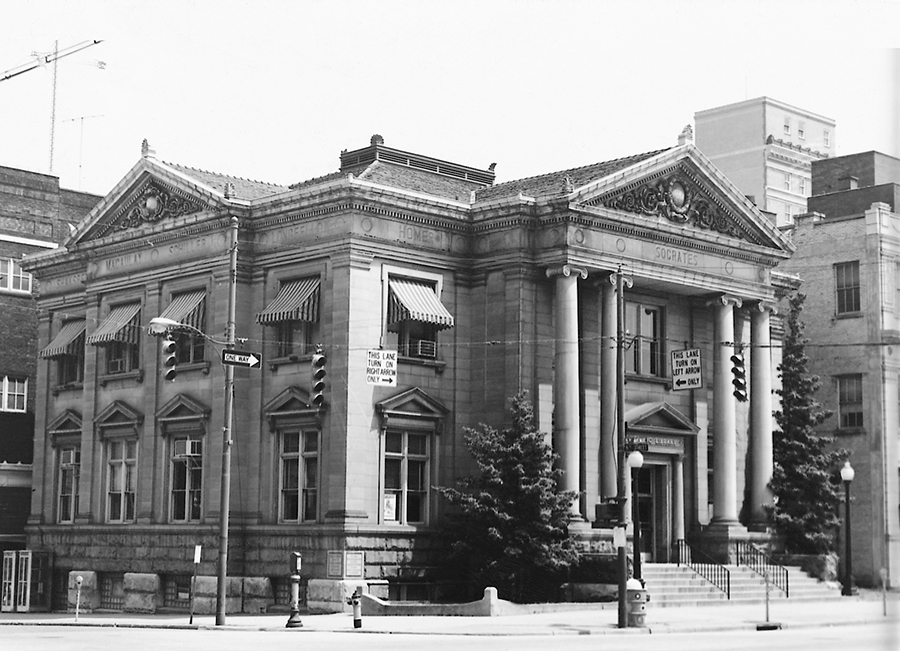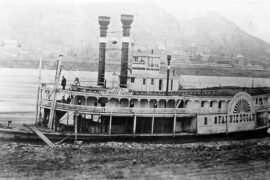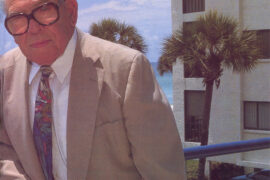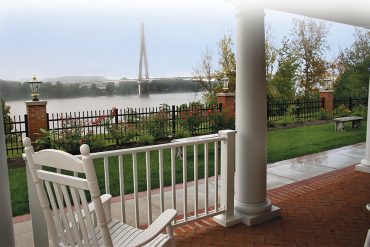Huntington’s first public bookcase is filled with history and architectural beauty.
By Joseph Platania
HQ 24 | SPRING 1996
Like many Huntingtonians, I received my first library card inside the imposing, two-story Carnegie Library located at the corner of Fifth Avenue and Ninth Street. That wonderful old library where, for a 10 cent bus ride, I could go check out books, opened up a new world for me.
Although the library no longer is housed in this stately downtown building, its cornerstone proclaims its turn-of-the-century origin. The inscription reads: “Public Library – Gift of Andrew Carnegie to the City of Huntington – A.D. 1902.” Even today, despite buildings of equal or larger proportions, the Carnegie Library stands as one of the city’s most striking landmarks.
Before the Carnegie Library, the reading public had to patronize small, private libraries operated by churches, women’s clubs and other associations and supported by memberships or “subscriptions.” According to a November 1952 Huntington newspaper article, the first Huntington Public Library opened its doors on April 7, 1902, in a storeroom on Fourth Avenue, a site that later became the Keith-Albee Theater. The library’s entire stock consisted of 750 books.
Within two years a new library building had been erected at Fifth Avenue and Ninth Street. Money for the building was provided by a grant from Pittsburgh industrialist-turned-philanthropist, Andrew Carnegie.
Carnegie was born in 1835 in Scotland, the son of a handloom weaver. In 1848 he emigrated with his impoverished parents to America, where they settled in Allegheny, Pa., now part of Pittsburgh. Self-educated, he rose to become the nation’s pre-eminent steel manufacturer.
In 1901, Carnegie decided to retire and devote his efforts to philanthropy, selling his company for almost $500 million to the combine that was creating U.S. Steel.
In magazine articles and in his book, The Gospel of Wealth (1900), Carnegie had espoused the view that the rich should distribute their wealth during their lifetime. Although he gave away his money for a variety of purposes, libraries were to be his specialty in the early phase of his philanthropic career. He would donate the building and require that the town tax itself for the books and maintenance.
In the library-giving process, a town council would apply for a library building. The town would first have to provide a site, preferably centrally located in the town, then the governing body of the community would have to pledge an annual appropriation for books and maintenance which would amount to ten percent of the Carnegie grant. The size of the gift was based on the population of the town, usually two dollars per capita, which worked well for cities from 25,000 to 100,000 in population.
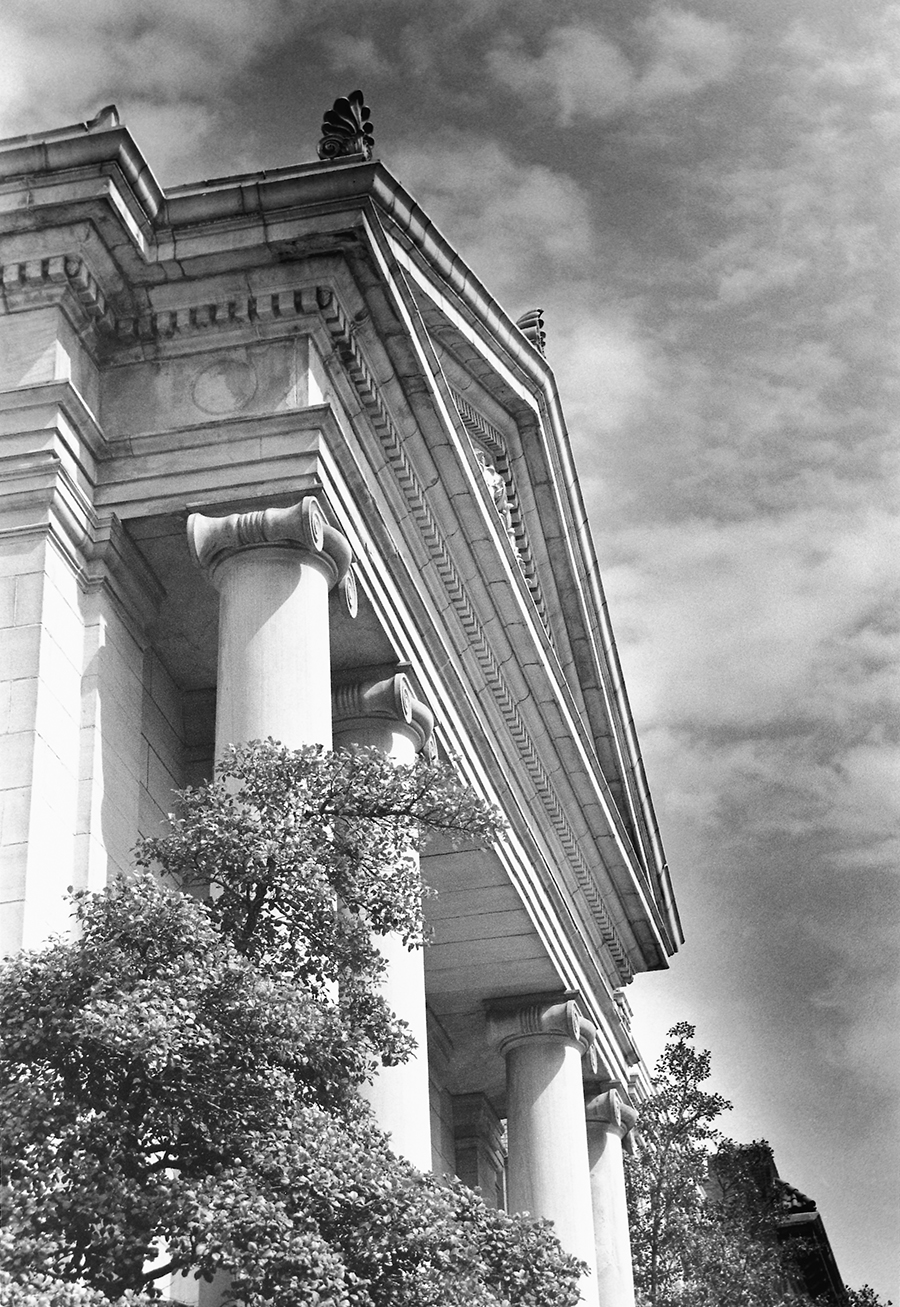
Carnegie’s interest in giving libraries was based on his philosophy that this would “make available to everyone a means of self-education,” states a biographer. From 1900 to 1917, when the library-building program terminated, the Carnegie organization gave money for 2,811 free public libraries worldwide, of which 1,946 were located in the United States. The total cost for all libraries was in excess of $50 million. Those in the U.S. cost nearly $45 million. Every state in the Union, the District of Columbia and Puerto Rico had at least one Carnegie library.
As a result of Carnegie’s philanthropy, the free library became almost as much a part of America as the schoolhouse and the church. These buildings became his most enduring claim to popular fame.
According to the 1919 Manual of Public Benefactions of Andrew Carnegie, grants for libraries were offered to eight West Virginia cities but only four Carnegie libraries were built: Huntington (1903), Parkersburg (1905), Hinton (1912) and Bethany College (1905).
Huntington’s Carnegie Library came into existence largely because of the initiative of W.H. Cole, the super-intendent of city schools, who in the fall of 1901 began correspondence with the Carnegie organization in New York City. According to The Huntington Advertiser, this correspondence “resulted on December 31 in the offer of $25,000 for a library building.”
On January 6, 1902, the Huntington Independent District Board of Education met to consider the offer contained in a letter written by Carnegie’s secretary, James Bertram, as follows:
“If the City of Huntington will pledge itself by resolution of council to support a free library at a cost of not less than twenty-five hundred dollars a year and will provide a suitable site, Mr. Carnegie will be glad to furnish twenty-five thousand dollars for a free library building.”
The board enthusiastically accepted Carnegie’s offer and on January 10 the city council, in special session, donated a lot 90 feet by 90 feet at the northeast corner of Ninth Street and Fifth Avenue. “The finest location in the city,” said the Advertiser, and instructed the mayor and city clerk to execute a deed transferring the property to the board of education.
Certified copies of the official action of the board and city council were sent to Carnegie and on February 3 notice was received from his New York office to contact his agent for $25,000 as needed in the construction of the building.
According to an April newspaper article, although $25,000 was considered “ample … for a splendid library,” it was thought that in order to provide more fully for a larger range of uses, a music hall or auditorium should be constructed in connection with the building for $10,000 extra.
It was then decided to present the matter to Carnegie, requesting him to increase his gift to $35,000. On March 24, 1902, the request was answered that “he will increase his donation for the building to $35,000 if the city will increase its guarantee to $3,500.”
The board of education extended its thanks to Carnegie for his additional gift of $10,000 and pledged to “maintain the library at an annual expense of not less than $3,500 for maintenance and increase of the library.”
On April 2, a letter was received authorizing the board to contact Carnegie’s agent for $35,000. This was an above-average size gift in relation to Huntington’s population of only 15,000.
On April 10, after considering a number of plans submitted by architects from around the country, the plans submitted by James B. Stewart, a well-known Huntington architect, were adopted by the board of education. Stewart was chosen as architect and superintendent of construction. A few years later Stewart designed the Frederick Building as well.
In July the contract for the erection of the building was given to the local firm of Shore and Odell. It took all summer and into the fall for workmen to excavate the basement and to lay the elaborate “rusticated” (in masonry, rustic means a rough surface with deep joints) base and foundation.
A lavish cornerstone laying ceremony was held on Nov. 14, 1902, that was presided over by W.H.H. Holswade, president of the board of education and Huntington Mayor H.C. Gordon. The newspaper re -ported that despite overcast skies and threatening weather, a large crowd gathered for the occasion. Also in attendance were L.J. Corbly, president of Marshall College and W.H. Cole, superintendent of schools.
The style of architecture chosen for the building was classical Greek, in particular that of the Ionic order. This style was thought to be “especially appropriate for a library,” said the newspaper, adding “there was no other building in the city in the classical Greek style.”
Bedford limestone was selected for the foundation and Cleveland sandstone for the superstructure. The roof was to be of “home-manufactured tile or clay shingles” in a “rich, cherry red color making a very beautiful and durable roof,” stated the newspaper.
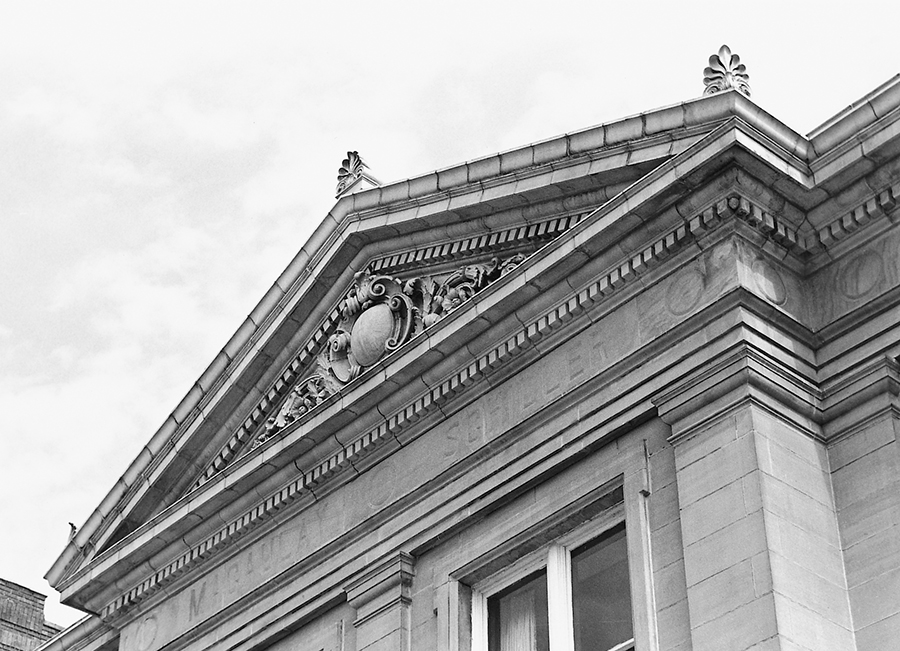
On April 12, 1903, an examiner from the Carnegie organization visited Huntington to check on the progress of the library. The Advertiser reported that the examiner was “very much pleased with the progress of the building” and “was surprised it was to be built for $35,000.”
By mid-December most of the building above the foundation had been completed.
According to board of education records, the board contributed more than $1,600 above the $35,000 cost so that the building would be made entirely of light brown sandstone.
At the end of 1903, the nearly-completed library was praised as “the most outstanding edifice of which Huntington can boast” and was “the most pretentious building on government Square.” This was the name given to the wide area between Eighth and Ninth Streets on Fifth Avenue that was bordered by nearby city hall and the courthouse.
In April 1904, after nearly two years labor, the Carnegie Library was completed. According to a lengthy article in the Advertiser, the library was regarded as an integral part of the city’s educational system. The board of education was authorized to make the necessary levy from year to year to equip, increase and maintain the city’s new bookcase.
The newspaper described the new building’s first floor as “devoted to the library stacks for books; the delivery desk counter for the librarian; a reading room for children, another for adults; and still another for a reference library and investigations.”
Also on the first floor were the offices of the board of education and the superintendent of instruction.
The stack room was arranged for two stories of stacks with room for 50,000 books. There also was an area for an art gallery “until space is needed for books,” said the newspaper.
The auditorium, which measured 76 ft. by 72 ft., was located on the second floor and had a capacity of 600 people. The ceiling of this room, as well as those in the rest of the library, was made of steel.
The library with its auditorium was envisioned as providing a place for “educational entertainment” such as lectures, concerts and recitals.
The basement was described as “more than half above ground … well- lighted and ventilated, with entrances from outside and from the foyer or vestibule.”
The building also was foreseen as providing space for “night schools” for those who worked during the day.
The reporter concluded with the hope: “Thus may the public library become one of the brightest jewels in Huntington’s educational crown.”
The Carnegie Library was built at a time when Beaux Arts Classicism was an architectural style at the height of popularity. This style was based on the culture, art and literature of ancient Greece and Rome and is characterized “by emphasis on form, simplicity, proportion and restrained emotion.”
The most interesting architectural features of the Carnegie building are its rusticated raised basement and the pavilion of the front entrance with the tall paired Ionic columns of its portico. The “triangular pedimentation” (a pediment is a wide, low-pitched gable surmounting the facade of a building) of the ground floor entrance area is repeated on a grand scale by the greater porticoed pediment near the top of the building that is embellished with decorative trim fashioned of terra cotta.
On the library’s upper section which, in buildings of classical design is called an “entablature,” are carved the names of classical and literary figures. On the entablature of the west side are the names of Shakespeare, Macauley, Schiller and Longfellow. On the front entablature are the names Homer, Socrates and Plato; and on the east Virgil and Goethe.
A 1980 architectural description of the library praised its “precise symmetry and academically correct placement of classical detail” which distinguish the two major levels of the building.

The Carnegie Library opened its doors to the public in April 1904 with Miss Adrienne Burns as the first librarian. At the time the library had only 750 books on its shelves. Four years later when Miss Burns was succeeded as librarian by Miss Lewis Harvey, the collection had grown to 6,000 books, many of them donated by the citizens of Huntington.
Miss Harvey’s service was the longest in West Virginia history, spanning 35 years from 1908 to 1943.
In 1912 a Juvenile Department for young people, located in the raised basement, was added.
From the time of its opening the library housed the offices of the board of education until city and county schools were combined in 1933. With the introduction of the county unit of schools, all residents of Cabell County became eligible to borrow books from the new Huntington library.
It was not until November 1942 that the Carnegie Library was devoted exclusively to library purposes. At that time the entire second floor was renovated to be used as a reference room and the circulation department was expanded to occupy all of the first floor.
From 1903 to 1945, the Carnegie Library was supported solely by the Board of Education. In 1945 the Cabell County Commission assumed participation in its financial support. The following year branch libraries in Barboursville and Milton were established.
By the mid-1970s it was apparent the library had outgrown its building. On December 10, 1977, ground was broken for the new Cabell County Public Library on cleared urban renewal land on the west side of Ninth Street, near Fifth Avenue.
On April 15, 1980, the Carnegie Library was placed on the National Register of Historic Places by the U.S. Department of the Interior.
In September 1980, hundreds of volunteers helped the staff move the library’s nearly 150,000 books into their new home on the Ninth Street Plaza. On November 30, 1980, the new $3 million library building was dedicated.
Following a brief stint as a bar/restaurant, the Carnegie building was sold to the Huntington Junior College of Business in 1985.
Cabell County is headquarters for the Western Counties Regional Library which includes Mingo, Putnam and Wayne counties. The Cabell branches include West Huntington, Guyandotte, Gallagher Village, Barboursville, Milton, Salt Rock and Cox Landing. In addition, the library provides extension services to schools, senior citizens’ facilities and communities through the Bookmobile Department.
In 1983 the Cabell County Library became the first in the state to computerize. It is a fully automated library system with computers providing all of the information traditionally stored in the card catalog. All branches in Cabell County are online, as are those in Wayne, Putnam and Mingo counties.
Everyone who lives in West Virginia and in Lawrence and Gallia counties in Ohio is entitled to a free library card which can be used at the main library, all branches and the bookmobile.
The Audiovisual Department on the main library’s third floor has filmstrips, projectors, screens, recorders and video, audio and book cassettes that may be checked out for 24 hours.
The Cabell County Library, its branches and bookmobile have a stock of 285,000 books. On a typical weekday more than 1,500 people visit the library and its branches for a variety of reasons from book and audiovisual loans to story hours for children. There also are magazines and newspapers, research materials, meeting rooms and adult literacy programs available to the region.
All in all, a good return for a $35,000 investment made in a 750 book library some 90 years ago.

